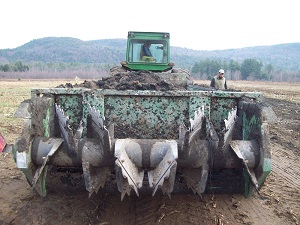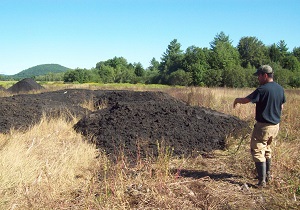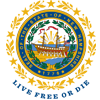Biosolids
Developing standards for the land application of biosolids.
 Sludge is a solid or semisolid material derived from the water or wastewater treatment (WWTF) process. Biosolids are derived from sludge that has been treated to reduce pathogens and meet federal and state pollutant regulatory limits and standards. About 50% of the nation’s wastewater sludge is recycled to land application as Biosolids. In New Hampshire, about 35% to 40% of the total sludge produced annually from WWTFs is recycled to land application. Beneficial Use of Biosolids is the practice of using the nutrients and organic matter present in biosolids to grow vegetation and establishing soil tilth. This is a sound practice for recycling carbon back into the soil through soil carbon sequestration as long as it does not pose a significant threat to human health and the environment.
Sludge is a solid or semisolid material derived from the water or wastewater treatment (WWTF) process. Biosolids are derived from sludge that has been treated to reduce pathogens and meet federal and state pollutant regulatory limits and standards. About 50% of the nation’s wastewater sludge is recycled to land application as Biosolids. In New Hampshire, about 35% to 40% of the total sludge produced annually from WWTFs is recycled to land application. Beneficial Use of Biosolids is the practice of using the nutrients and organic matter present in biosolids to grow vegetation and establishing soil tilth. This is a sound practice for recycling carbon back into the soil through soil carbon sequestration as long as it does not pose a significant threat to human health and the environment.
In 2016, PFAS contamination in biosolids became a topic of discussion around the country. In 2017, the NHDES Residuals Management Section (RMS) began its investigation sampling the biosolids recycled within New Hampshire. RMS has been annually sampling all biosolids currently being land applied using funding from Governor Sununu’s PFAS investigation fund allocated to NHDES. By adding PFAS sampling requirements, establishing education outreach workgroup sessions for industry professionals, and continuing to sample the biosolids land applied in New Hampshire RMS continues to work on helping communities improve the chemical and physical properties of biosolids while investigating the fate and transport of PFAS in wastewater. Source pollution prevention will help reduce the concentrations of these contaminants present in wastewater and sludge/biosolids, which will allow for WWTFs to recycle biosolids well into the future. Without posing a significant risk to human health and the environment.
 Sludge Quality Certificate PFAS sampling requirement revision
Sludge Quality Certificate PFAS sampling requirement revision
In the spring of 2019, the NHDES Biosolids Program revised each permit for every generator of biosolids for New Hampshire distribution to require the sampling and analysis for PFAS in their biosolids. RMS also now require each generator approved to distribute biosolids to include descriptions in their annual report on the measures they have taken that year to reduce the concentrations of PFAS present in their biosolids. These measures include sampling and identification of sources inputting PFAS into the sewer collection system, distributing outreach material to the public, and working with federal and state officials on better understanding the fate and transport of PFAS in wastewater and biosolids.
How can you help reduce PFAS in wastewater and sludge?
Source pollution prevention will help reduce these contaminants concentrations present in wastewater and sludge/biosolids, which will allow for biosolids recycling to continue into the future. Reducing the amount of PFAS we discharge to the sewer collection system will allow for biosolids to not pose a significant risk to human health and the environment.
RMS Interim Guidance for Emerging Contaminants in Certified Biosolids
In 2020, RMS published a fact sheet to educate residuals managers, end users of biosolids and the public of the impacts emerging contaminants have on biosolids and what they can do now, while federal and state regulatory agencies work on approved test methods and standards for biosolids.



